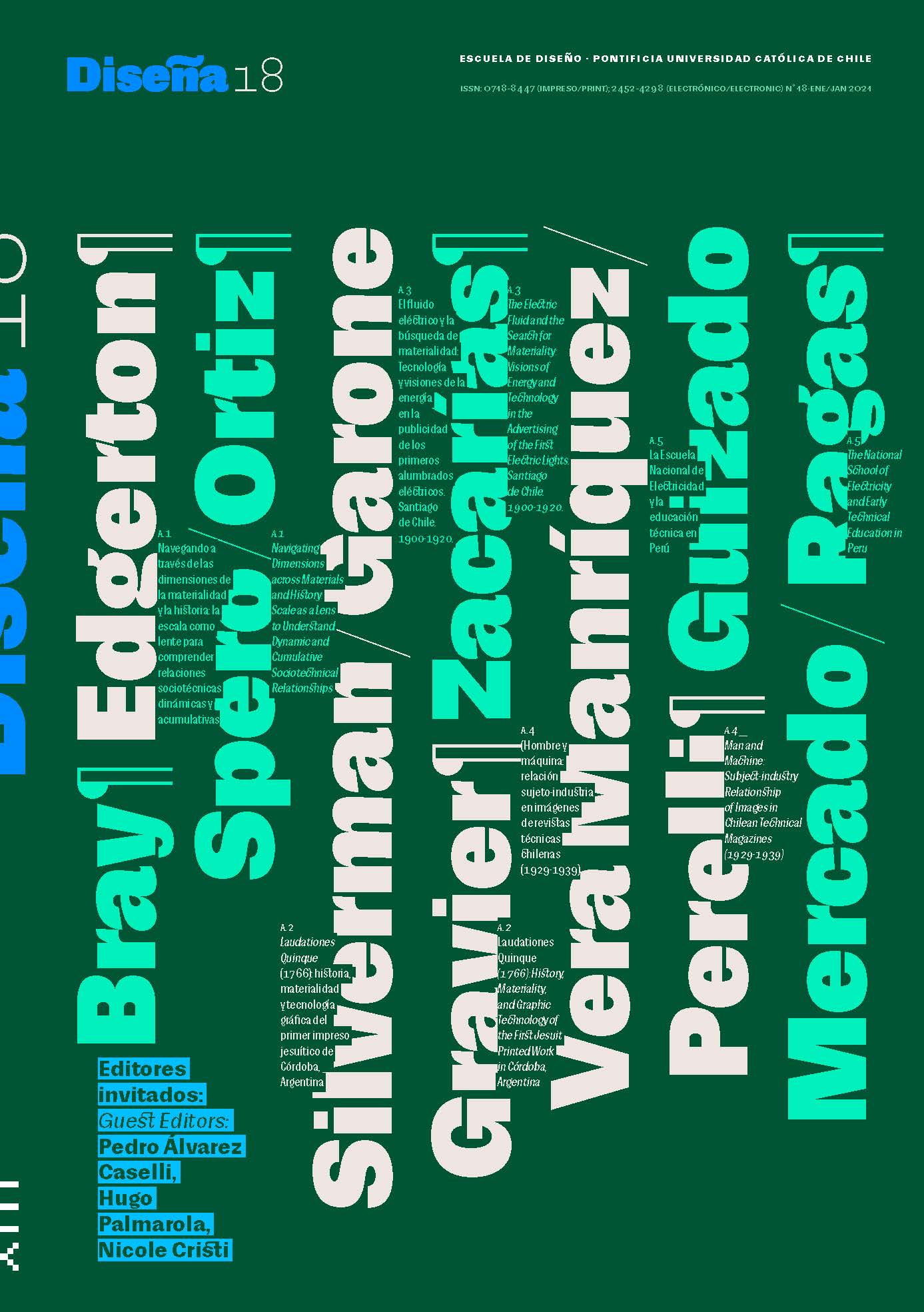Editorial. ʽTrajectories of Useʼ and ʽThe Object as Producer and Userʼ: Two Ideas for Historiographical Subversion
DOI:
https://doi.org/10.7764/disena.18.EditorialAbstract
This editorial contributes two ideas to the discussion proposed by the guest editors concerning the dimension of use of technical objects. In the first place, it proposes incorporating the idea of ‘trajectories of use.ʼ The concept is built upon the notions of ‘technological adjustmentʼ and ‘technological reconstitution,ʼ both proposed by Pfaffenberger, as well as from the ideas raised by Domínguez Rubio regarding what he calls the ‘relentlessness of things.ʼ The second idea is that Barad’s relational ontology is useful for outlining historiographic programs that respond to the urgent need to creatively subvert methods, conceptual frameworks, and traditional categories. This idea is developed according to Francesca Bray’s proposals, on the one hand, and Giaccardi and Redström, on the other, who coincide in pointing out that the limits between production and use, have collapsed.
References
BARAD, K. (2003). Posthumanist Performativity: Toward an Understanding of How Matter Comes to Matter. Signs: Journal of Women in Culture and Society, 28(3), 801–831. https://doi.org/10.1086/345321
BRAY, F., HAHN, B., LOURDUSAMY, J. B., & SARAIVA, T. (2019). Cropscapes and history: Reflections on rootedness and mobility. Transfers, 9(1), 20–41. Scopus. https://doi.org/10.3167/TRANS.2019.090103
DOMAŃSKA, E. (2020). The Paradigm Shift in the Contemporary Humanities and Social Sciences. En J.-M. Kuukkanen (Ed.), Philosophy of History: Twenty-First-Century Perspectives (pp. 180–197). Bloomsbury.
DOMÍNGUEZ RUBIO, F. (2016). On the Discrepancy between Objects and Things: An Ecological Approach: Journal of Material Culture, 22(1), 59–86. https://doi.org/10.1177/1359183515624128
DUNNE, A. (1999). Hertzian Tales: Electronic Products, Aesthetic Experience, and Critical Design. MIT Press.
ESCOBAR, A. (2016). Autonomía y diseño: La realización de lo comunal (Cristóbal Gnecco, Trad.). Universidad del Cauca.
FRY, T. (2015). Whither Design/ Whether History. En T. Fry, C. Dilnot, & S. Stewart, Design and the Question of History (pp. 1-130). Bloomsbury.
FRY, T., DILNOT, C., & STEWART, S. (2015). Design and the Question of History. Bloomsbury.
FRY, T., & WILLIS, A.-M. (2015). Steel: A Design, Cultural and Ecological History. Bloomsbury.
GIACCARDI, E. (2019). Histories and Futures of Research through Design: From Prototypes to Connected Things. International Journal of Dsign, 13(3). http://www.ijdesign.org/index.php/IJDesign/article/view/3192/875
GIACCARDI, E., & REDSTRÖM, J. (2020). Technology and More-Than-Human Design. Design Issues, 36(4), 33–44. https://doi.org/10.1162/desi_a_00612
HARMAN, G. (2016). Immaterialism: Objects and Social Theory (1a ed.). Polity.
KNORR CETINA, K. (1997). Sociality with Objects: Social Relations in Postsocial Knowledge Societies. Theory, Culture & Society, 14(4), 1–30. https://doi.org/10.1177/026327697014004001
KUUKKANEN, J.-M. (2020). A Conceptual Map for Twenty-First-Century Philosophy of History. En J.-M. Kuukkanen (Ed.), Philosophy of History: Twenty-First-Century Perspectives (pp. 1–19). Bloomsbury.
LECAIN, T. J. (2017). The Matter of History: How Things Create the Past. Cambridge University Press.
PFAFFENBERGER, B. (1992). Technological Dramas. Science, Technology, & Human Values, 17(3), 282–312.
TAMM, M., & SIMON, Z. B. (2020). Historical Thinking and the Human: Introduction. Journal of the Philosophy of History, 14(3), 285–309. https://doi.org/10.1163/18722636-12341451
Published
How to Cite
Issue
Section
License

This work is licensed under a Creative Commons Attribution-ShareAlike 4.0 International license.
COPYRIGHT NOTICE
All contents of this electronic edition are distributed under the Creative Commons license of "Attribution-ShareAlike 4.0 Internacional" (CC-BY-SA). Any total or partial reproduction of the material must mention its origin.
The rights of the published images belong to their authors, who grant to Diseña the license for its use. The management of the permits and the authorization of the publication of the images (or of any material) that contains copyright and its consequent rights of reproduction in this publication is the sole responsibility of the authors of the articles.





